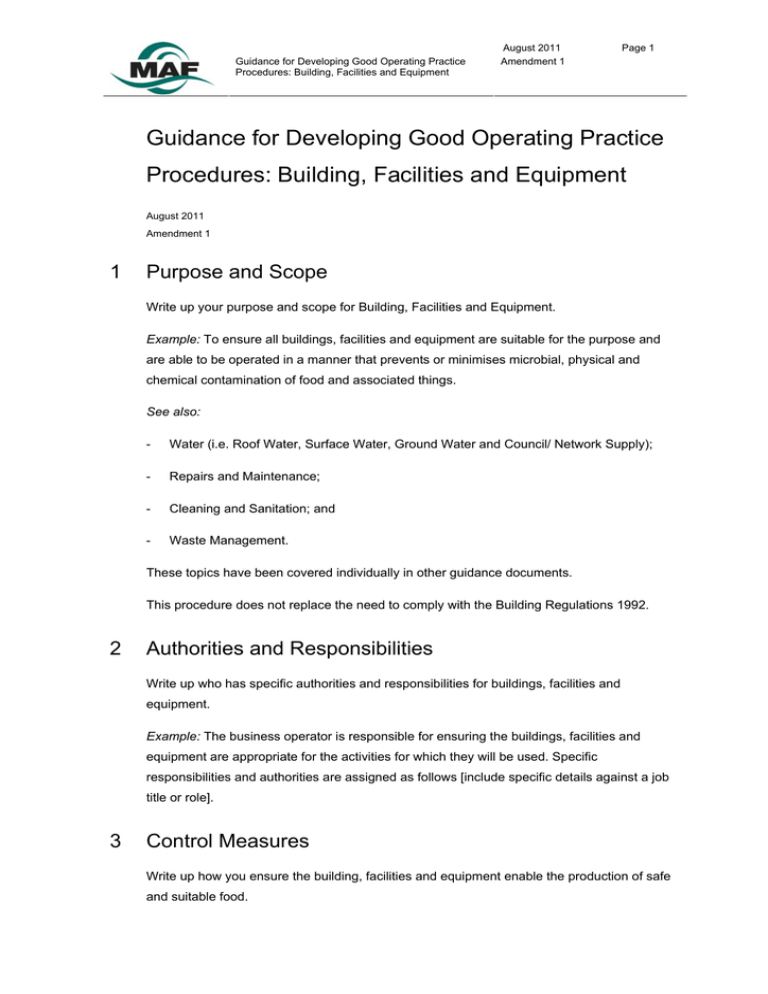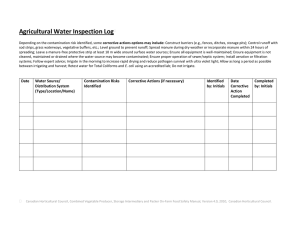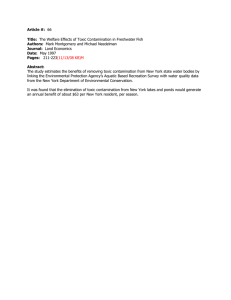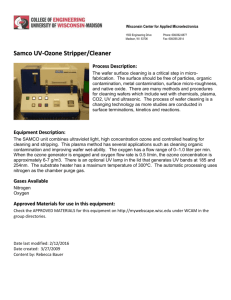Food Safety: Good Operating Practices for Buildings & Equipment
advertisement

Guidance for Developing Good Operating Practice Procedures: Building, Facilities and Equipment August 2011 Amendment 1 Page 1 Guidance for Developing Good Operating Practice Procedures: Building, Facilities and Equipment August 2011 Amendment 1 1 Purpose and Scope Write up your purpose and scope for Building, Facilities and Equipment. Example: To ensure all buildings, facilities and equipment are suitable for the purpose and are able to be operated in a manner that prevents or minimises microbial, physical and chemical contamination of food and associated things. See also: - Water (i.e. Roof Water, Surface Water, Ground Water and Council/ Network Supply); - Repairs and Maintenance; - Cleaning and Sanitation; and - Waste Management. These topics have been covered individually in other guidance documents. This procedure does not replace the need to comply with the Building Regulations 1992. 2 Authorities and Responsibilities Write up who has specific authorities and responsibilities for buildings, facilities and equipment. Example: The business operator is responsible for ensuring the buildings, facilities and equipment are appropriate for the activities for which they will be used. Specific responsibilities and authorities are assigned as follows [include specific details against a job title or role]. 3 Control Measures Write up how you ensure the building, facilities and equipment enable the production of safe and suitable food. Guidance for Developing Good Operating Practice Procedures: Building, Facilities and Equipment August 2011 Amendment 1 Page 2 Consider at least the following points (as appropriate): 3.1 Location how you ensure the location has been given proper consideration with regard to: - it’s proximity to incompatible land uses or industrial activities that could pose a contamination threat to the food (e.g. effluent run-off onto areas where horticultural produce is grown; spray drift from neighbouring activities); - any historical uses that could result in contamination or unacceptable residues in food; and - the provision of essential services (including availability of water of sufficient quality to prevent or remove contamination from food). 3.2 Design and Construction how you determine that the building and facilities are well designed and constructed, which: - ensures materials of exposed internal structures are not a source of contamination for food; - is appropriate for the activities for which they are used and is able to be effectively cleaned, and where necessary sanitised; - gives proper consideration to the availability of essential services (electricity, gas, hot and cold water supplies, drainage) and ensuring water is of sufficient quality for its intended use; - provides an adequate number of facilities to enable good hygienic practices to be followed (including flushable toilets and hand washing basins supplied with hot and cold or tempered water supply); - has adequate storage facilities for the storage of items that are a potential source of contamination of food (e.g. personal belongings including clothing and bags; cleaning equipment and chemicals, maintenance compounds and tools); - provides adequate space for the fixtures, fittings and equipment that are used for those activities (including easy access for cleaning and inspection); - enables effective separation of raw and ready-to-eat foods; Guidance for Developing Good Operating Practice Procedures: Building, Facilities and Equipment - August 2011 Amendment 1 Page 3 permits satisfactory working conditions and workflows to facilitate good practices for the type, range and volume of food, food handlers and any others who might be there (i.e. the workflow follows a linear progression from incoming raw materials through to finished product, and ideally ensures that food and waste products never cross-paths or comingle); - provides adequate facilities and equipment for the collection and containment of waste (including drainage and containment of liquid waste); - protects against: dust, dirt, fumes, smoke and other external environmental contaminants; the build-up of dirt, mould, condensation, the shedding of particles and other internal environmental contaminants. Where there is an air-filtration system, the air flow runs counter to product flow (i.e. clean filtered air moves with a positive pressure from the cleanest areas at packaging and packing back towards the receiving area). Physical barriers such as air-curtains can isolate receiving and shipping areas that may be open to the outside environment; the build-up/ponding of water on floors; and contamination of food from other (e.g. non-food) activities that may take place in the building. - deters entry by pests; and - where re-circulated water is used, the water flow runs counter to product flow so that incoming water is used for the cleanest uses. 3.3 Fixtures, Fittings and Equipment how you ensure the fixtures, fittings and equipment are adequate for the production of safe and suitable food, including. - sufficient lighting to enable all process operations, monitoring checks and inspections/verification activities to be carried out; - adequate ventilation and insulation to prevent condensation from forming which could harbour moulds, Listeria and other micro-organisms that could contaminate food; and how you ensure the fixtures, fittings and equipment are: Guidance for Developing Good Operating Practice Procedures: Building, Facilities and Equipment - August 2011 Amendment 1 Page 4 appropriate for their intended use, including being capable of achieving any critical limits for food safety that they are intended to achieve (e.g. cooking temperatures achieved by an oven) or maintaining a controlled temperature (e.g. to meet shelf life); - designed, constructed, located and installed so that there is no likelihood that they will cause contamination of food; - suitable to ensure effective cleaning (and sanitising) - colour-coded, or otherwise identifiable, wherever it is necessary to ensure equipment does not move between segregated areas (e.g. bins, totes, cleaning tools etc); - able to be effectively cleaned and sanitised; - not able to harbour pests; and - not able to absorb liquid, food or grease. how you can be sure of the reliability of measuring equipment and instruments used for critical measurements (i.e. calibration against a known standard). 4 Monitoring Write up/describe how you check that your controls are effective. Consider the following periodic checks: construction and/or installation operates as designed; air ventilation systems can operate in accordance with the manufacturers’ instructions; commissioned equipment remains in accordance with the manufacturers’ specifications; calibration checks are. in accordance with the manufacturer-recommended interval/after an event etc.; and reviewing customer complaints and any internal checks that relate to the building, facilities and equipment for trends that need corrective action. 5 Corrective Action Write up/describe how you correct any problems that monitoring identifies, or that you otherwise become aware of. Guidance for Developing Good Operating Practice Procedures: Building, Facilities and Equipment August 2011 Amendment 1 Page 5 Include how you cover the following: 1. Defining the extent of the problem (i.e. what has happened, where it occurred and when, why it happened, how much product (if any) is affected); 2. Restoring control (i.e. the action needed immediately to stop more product becoming affected and to fix problem); 3. Handling affected food (e.g. preventing any unsafe product from being released see the separate guidance for Complaints, Non-conforming Product, Corrective Action and Recall); and 4. Prevent re-occurrence (e.g. using information gained from the problem to identify better ways to do things; develop better procedures; improve the checking systems; provide better staff training, etc.). 6 Documentation and Record Keeping Determine what records you need to keep for this building, facilities and equipment procedure. These will help you to introduce and maintain consistent good practices, and to demonstrate to your verifier (auditor) that you are sufficiently controlling those factors that can impact on the safety and suitability of the food. Records may include site/design plans and equipment manufacturers’ specifications/operating instructions. Assess any records you already have, and introduce any additional records you need for the monitoring and corrective action activities you specify in your procedure. When monitoring, you may have an option to either: - record every check; or - indicate that checks have regularly been carried out (e.g. throughout a week) and only record the results of a specific check where something went wrong. In these instances, always make a record of what you did to put things right (the corrective action). Keep blank record forms handy for staff to use and let people know where they are. Keep completed record forms together where they can be found easily for your regular internal verification checks. For your general programme requirements refer to the guidance document on the appropriate risk-based programme or plan which can be found on the Food Safety website.




